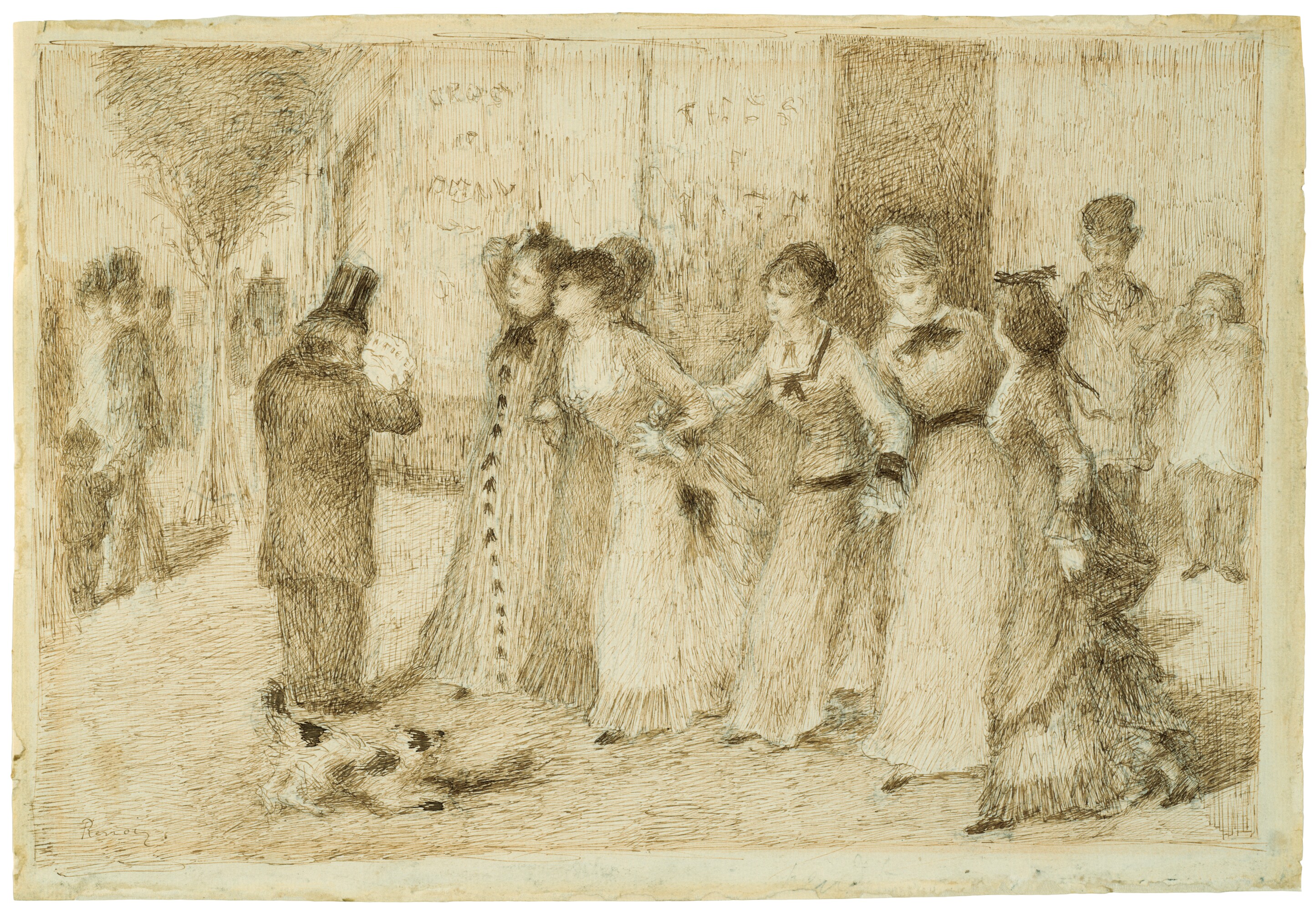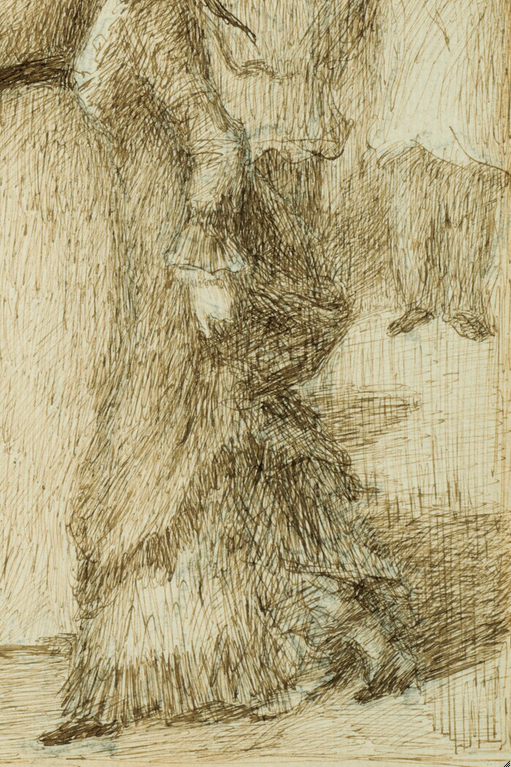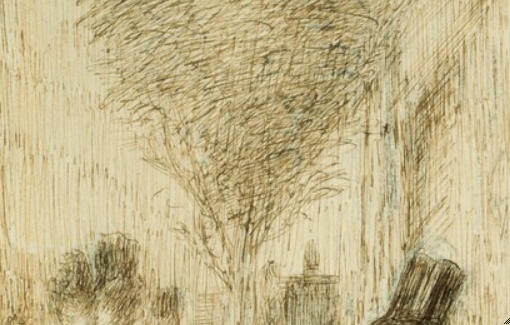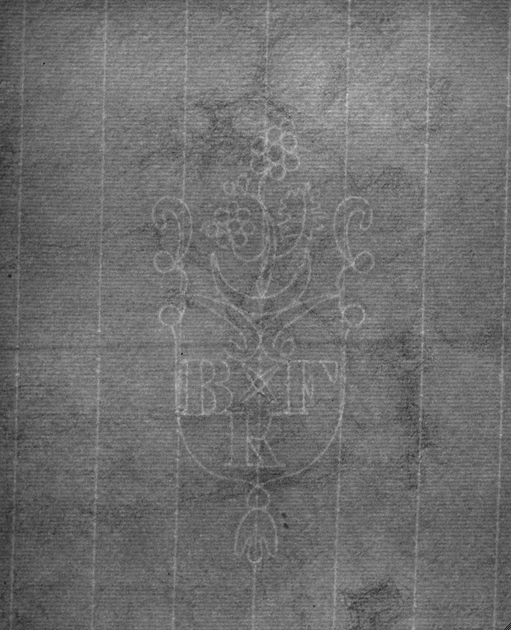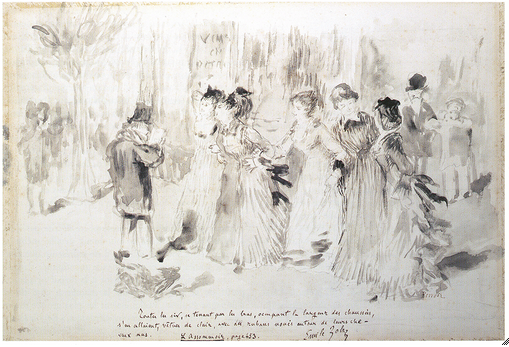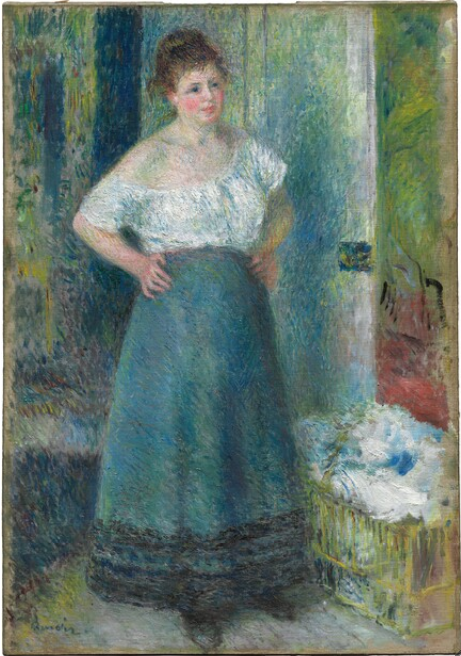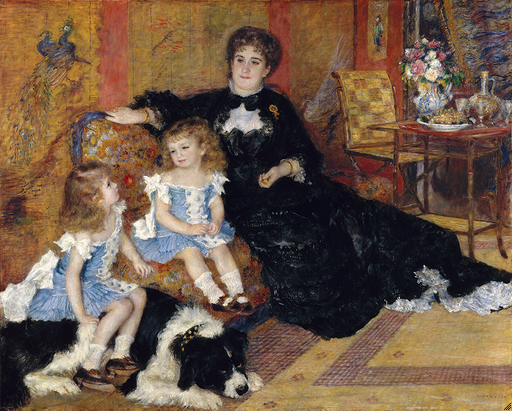Cat. 5
Workers’ Daughters on the Outer Boulevard (Illustration for Émile Zola’s “L’assommoir”)
1877/78
Pen and brown ink, over black chalk, on ivory laid paper; 275 × 399 mm
The Art Institute of Chicago, Regenstein Collection, 1986.420
A group of six young women stand on a Paris street, close together, their arms intertwined. One strains forward, her chest pushed out, hands on hips. Behind, at the far right of the sheet, stand two men. One cups his hands to his mouth as if to shout; the other, more subdued, wears his cap tipped down. They wear smocks rather than jackets, perhaps just having left work. A man in a top hat stands before them; he hunches over a newspaper, ignoring their provocations. At the far left of the composition a family, presumably mother, father, and son, is distanced spatially and socially from the band of young women.
To read this image as a narrative is entirely appropriate. It illustrates a scene from Émile Zola’s L’assommoir, an exposé about hard drinking and its social consequences that caused something of a scandal in the late 1870s. The seventh in Zola’s series chronicling the Rougon-Macquart family, the story revolves around the laundress Gervaise. Her headstrong daughter Anna, nicknamed Nana, first appears to the reader toward the close of the book. In this drawing she appears simply as the most prominent of the cavorting adolescents.
Another drawing by the artist—now in the collection of Jean Bonna—is also clearly associated with L’assommoir. That sheet (fig. 5.5 [Dauberville 677]), a looser, more freely worked study executed in brush and ink, includes Zola’s inscription and even a page number at the bottom: “Off they went, the six of them, taking up the whole width of the road, arm in arm in their light dresses, their hair tied with ribbons.” It seems likely that the Art Institute’s version of the scene was produced in pen and ink because the Bonna drawing, lacking definition, would have been unsuitable for reproduction.
Renoir did not make his illustration for the novel’s debut appearance in print. L’assommoir was serialized in 1876 in the democratic newspaper Le bien publique. In 1877 Georges Charpentier published it in full; its popularity soon necessitated reprints. Like Zola, Renoir found a supporter in Charpentier, and in the same year that he made the book illustrations, he painted the publisher’s wife (fig. 5.6 [Daulte 266; Dauberville 239]). The Art Institute’s work was commissioned by Charles Marpon and Ernest Flammarion for a deluxe edition of the novel published in 1878. They requested contributions from ten artists, including Henri Gervex, André Gill, Georges Clairin, and Frédéric Régamey. Renoir’s four contributions differed markedly from the others, which focused on the violence and unpleasantness of the novel. The sympathetic appearance of the present scene is in evident contrast to such images as Gill’s Fight between Gervaise and Virginie, in which the two characters attack one another ferociously, their bare legs and arms on show.
In its multifigure composition and rich detail, Workers on the Outer Boulevard is the most elaborate of Renoir’s efforts for L’assommoir. Whether by design or coincidence, the subject of the passage was well suited to the artist’s flair for the sensual. The section in which the drawing appears tells of the fifteen-year-old Nana’s precocious beauty—“fully developed and no corset, with a real magpie face, milky complexion and skin as velvety as a peach.” Zola explains that Nana and her friends were born and raised on the streets—and, consequently, assumed ownership thereof—but Renoir subdues the vulgarity of the laughing, shouting characters even while depicting their exuberance. In the drawing, Nana is the third figure from the left among the group of girls. In a sheet in which the surface is mostly covered with a network of fine, closely spaced lines, Renoir’s relatively sparse use of media in her description makes her appear all the more vivid. An absence of ink creates an effect of falling light, which accentuates her bust and skirt, drawing attention to her curves. The artist emphasizes the attractiveness of the young women, perhaps mindful of Zola’s description of them “bursting their bodices by displaying their swelling forms.” Nana excited “obvious admiration”; an admiration, perhaps, that Renoir encouraged the viewer to ape.
There may have been no agenda behind the artist’s focus on the positive aspects of the text, but his dissatisfaction with Zola’s vision of the working classes may have informed his choice. Some years later, in conversation with the dealer Ambroise Vollard, Renoir recounted how he had frequented the salon of Madame Charpentier with Zola and others in the 1870s. Zola’s novel L’oeuvre (The Masterpiece), which depicts the life of a failed artist, had been the cause of many arguments in such circles, Renoir admitted, but his annoyance went beyond that infamous case. “I’ve always hated what he [Zola] writes,” he related. “When you want to paint an environment, you should start, so it seems to me, by putting yourself in your characters’ shoes. Zola, he is happy to open a little window, have a quick look outside, and assume that he has painted the people by saying that they smell bad.”
In addition to being an unabashed sensualist, Renoir had a well-documented preference for uneducated women. Finding lack of sophistication a virtue, it is likely that he delighted in—rather than disapproved of—the type of girl that Zola found crude. It is clear that in major works of this era, including Dance at the Moulin de la Galette (fig. 5.7 [Daulte 209; Dauberville 211]), shown in the third Impressionist exhibition of 1877, Renoir portrayed women of Nana’s class in a sympathetic light. And in 1898, as the art historian Colin Bailey has noted, Julie Manet recorded that Renoir viewed Montmartre families as sensitive souls, in marked contrast to Zola’s description of them as “atrocious beings.”
A painting of a laundress in the collection of the Art Institute (fig. 5.8 cat. 6) [Daulte 348; Dauberville 382]) also relates to L’assomoir and, once more, appears rather picturesque, given the novel’s general tone. Ostensibly it shows a washerwoman taking a moment’s pause. Renoir also revisited the theme some years later, in Washerwomen (fig. 5.9 [Dauberville 948]) and in a lightly drawn study, Laundress (1885–89; Courtauld Gallery, London); but these quasi-pastoral images are far removed from the celebration of youthful idleness that is Workers’ Daughters on the Outer Boulevard.
Nancy Ireson
Technical Report
Technical Summary
Workers’ Daughters on the Outer Boulevard (Illustration for Émile Zola’s “L’assommoir”) is one of three known drawings of the same subject. This work is executed in pen and dark-brown ink on ivory [glossary:laid] paper. [glossary:Infrared reflectography] has captured the faint, slightly smudged [glossary:underdrawing] in black chalk that Renoir used to lay out the composition. The final composition in ink follows the initial chalk underdrawing quite faithfully, providing great detail, as seen in an infrared overlay comparison (fig. 5.10). There are some additional lines at the upper center area, although they do not appear to form discrete elements in the composition (fig. 1.2).
The brown ink lines are thin and fairly consistent in length and thickness. Crosshatching and closely spaced lines are used to establish shading and modeling, and an absence of line creates areas of highlights (fig. 1.1). The ink lines bleed together in the dog’s spots at the left lower area to form the densest passages in the composition (fig. 5.11). The pen lines are generally oriented vertically or diagonally from the lower left to upper right, as is characteristic of right-handed artists. Changes in the direction of line distinguish the various elements in the composition: for instance, the lines delineating the tree foliage in the upper left corner are oriented diagonally/horizontally, whereas those establishing the background shop walls are straight and vertical. Slight deformations of the paper can be seen in the ink lines due to the pressure of the fine pen nib on the paper.
Signature
Renoir (recto, lower left corner, in pen and brown ink) (fig. 1.4).
Media and Support
Support Characteristics
Primary paper type
Ivory, medium-thick, slightly textured laid paper.
Watermark
BFK (for Rives BFK [Blanchet, Freres, & Kiebler]; in shield with two flowers and a crescent above and possibly a golden fleece below, complete, in center of sheet; 14.8 × 7.5 cm) (fig. 5.12).
Chain line orientation and frequency
Horizontal, 2.7 cm.
Laid line frequency
7–8 per cm.
Furnish
Uniform, without significant inclusions or colored fibers.
Formation
Even, likely machine made.
Other characteristics
All edges appear to have been trimmed and are slightly irregular.
Dimensions
275 × 399 mm.
Preparatory Layers
No artistic surface alterations or coatings are visible in normal conditions or under magnification. Under [glossary:UV] illumination, there is a light-yellow visible-light [glossary:fluorescence] overall on the paper surface that is characteristic of light gelatin surface [glossary:sizing]; the fluorescence is most pronounced around the perimeter where the window mat protected it from exposure to light.
Media Characteristics
The drawing was created in pen and brown ink over traces of black-chalk underdrawing; the ink lines are thin and fairly consistent in length and thickness.
Compositional Development
Black-chalk underdrawing is visible in the overall composition, as it was used initially to establish and define the figures before the drawing was worked out in pen and brown ink (fig. 5.10).
Surface Treatment
No artistic surface alterations or coatings are visible in normal conditions or under magnification. There is a light-yellow visible-light fluorescence that suggests the presence of light gelatin surface sizing.
Condition History
There are numerous losses and skinned areas along the edges on the verso, which may have resulted from the removal of a former edge mounting; the losses are filled. There is also light discoloration and staining from adhesive along the edges, visible on the recto. Soft undulations are visible in the sheet at the sides. There are faint inscriptions or smudges along the bottom edge. A strong vertical crease is visible through the center of the sheet; it is most evident on the verso. Dense areas of ink in the dog at the lower left penetrated through to the verso.
Kimberly Nichols
Provenance
Sold by Maurice Sachs (1906–1945), Paris, to De Hauke and Company, Inc., New York, July 1, 1929.
Sold by De Hauke and Company, Inc, New York, to John Nicholas Brown II (1900–1979), Newport, R.I., Oct. 16, 1929.
Estate of John Nicholas Brown II, Newport, R.I., from 1979.
Sold by the estate of John Nicholas Brown II to David Tunick, Incorporated, New York, c. 1986.
Sold by David Tunick, Incorporated, to the Art Institute of Chicago, 1986.
Exhibition History
New York, De Hauke and Company, Watercolors and Drawings of the 19th and 20th Century, Dec. 1929, no cat.
Providence, Rhode Island School of Design, Drawings and Paintings from the Collection of Mr. John Nicholas Brown, Apr. 2–27, 1931, no. cat.
Buffalo, N.Y., Albright Art Gallery, Master Drawings, Jan. 1935, cat. 122 (ill.).
New London, Conn., Lyman Allyn Museum, Drawings, Mar. 2–Apr. 15, 1936, cat. 162.
Boston, Museum of Fine Arts, Art in New England, June 8–Sept. 10, 1939, cat. 200 (ill.).
San Francisco, Calif., Palace of Fine Arts, Master Drawings: An Exhibition of Drawings from American Museums and Private Collections, 1940, pp. 22, 87, cat. 85 (ill.).
Omaha, Neb., Joslyn Art Museum, Dec. 1941.
San Francisco, California Palace of the Legion of Honor, 19th Century French Drawings, Mar. 8–Apr. 6, 1947, p. 64, cat. 105 (ill.).
Rotterdam, Boymans Museum, French Drawings in American Collections, 1958, cat. 181, pl. 165; Paris, Musée de Orangerie, 1959; New York, Metropolitan Museum of Art, 1959.
Newark, N.J., Newark Museum, Nineteenth Century Master Drawings, Mar. 16–Apr. 30, 1961, cat. 45 (ill.).
Cambridge, Mass., Fogg Art Museum, Forty Master Drawings from the Collection of John Nicholas Brown, Summer 1962, cat. 23.
Art Institute of Chicago, Masterpieces from the Helen Regenstein Collection, 1974–1989, Feb. 2–May 8, 1990, no cat.
New York, Frick Collection, From Pontormo to Seurat: Drawings Recently Acquired by The Art Institute of Chicago, Apr. 23–July 7, 1991, cat. 51; Art Institute of Chicago, Sept. 10, 1991–Jan. 5, 1992.
Vienna, Albertina, Impressionism: Pastels, Watercolors, Drawings, Feb. 9–May 13, 2012, p. 239, cat. 138 (ill.).
Selected References
Théodore Duret, Histoire des peintres impressionistes (H. Floury, 1906), p. 102 (ill.).
Ambroise Vollard, La vie et l’oeuvre de Pierre-Auguste Renoir (A. Vollard, 1919), p. 161 (ill.).
Joachim Gasquet, “Le paradis de Renoir,” L’amour de l’art 2 (Feb. 1921) (ill.).
Kimon Nicolaides, The Natural Way to Draw (Houghton Mifflin, 1941), p. 98 (ill.).
John Rewald, Renoir Drawings (H. Bittner, 1946), p. 15–16, no. 4 (ill.).
H. J. Wechsler, French Impressionists and Their Circle (Abrams, 1953), fig. 4, (ill.).
Ira Moskowitz, Great Drawings of All Time, vol. 3 (Shorewood, 1962), no. 798 (ill.).
Barbara Ehrlich White, Renoir: His Life, Art, and Letters (Abrams, 1984) pp. 83–84 (ill.).
Sophie Monneret, Renoir, Profils de l’art (Chêne, 1989) n.p., fig. 2 (ill.).
Hollis Clayson, Painted Love: Prostitution in French Art of the Impressionist Era (Yale University Press, 1991) p. 73–75, fig. 39 (ill.).
Douglas W. Druick, Renoir, Artists in Focus (Art Institute of Chicago/Abrams, 1997) p. 31–37, 83, no. 5, 109 (ill.).
Art Institute of Chicago, Treasures from The Art Institute of Chicago, selected by James N. Wood, commentaries by Debra N. Mancoff (Art Institute of Chicago/Hudson Hills, 2000), p. 206 (ill.).
Martha Tedeschi, “Pierre Auguste Renoir, Workers’ Daughters on the Outer Boulevard (Illustration for Emile Zola’s ‘L’Assommoir’), 1877/78,” in “Maineri to Miró: The Regenstein Collection since 1975,” special issue, Art Institute of Chicago Museum Studies 26, 1 (2000), pp. 78–79, no. 34 (ill.).
Suzanne Folds McCullagh, “‘A Lasting Monument’: The Regenstein Collection at The Art Institute of Chicago,” special issue, Art Institute of Chicago Museum Studies 26, 1 (2000), p. 13.
Paul Hayes Tucker, “Renoir in the 1870s and ’80s: Modernity, Tradition, and Individuality,” in Renoir: From Outsider to Old Master, 1870–1892, exh. cat. (Chūnichi Shinbunsha, 2001), p. 220, fig. 11.
Guy-Patrice Dauberville and Michel Dauberville, Renoir: Catalogue raisonné des tableaux, pastels, dessins, et aquarelles, vol. 3, 1858–1881 (Bernheim-Jeune, 2007), p. 619, no. 664 (ill.).
Other Documentation
Inscriptions and Distinguishing Marks
Recto
Mark
Location: center bottom edge
Method: graphite
Content: possibly J or L C (erased)
Examination Conditions and Technical Analysis
Raking Visible Light
Paper support characteristics identified.
Transmitted Infrared (Fuji 1.0–1.1 μm)
Watermark captured.
Transmitted Visible Light
Paper mold characteristics identified.
Ultraviolet-Induced Visible Fluorescence (365 nm)
Light surface sizing detected.
Infrared Reflectography (Fujifilm S5 Pro with X-Nite 1000B/2 mm filter [1.0-1.1 µm])
Overall faint black-chalk underdrawing captured.
Stereomicroscopy (80–100×)
Media identified.
Image Inventory
The image inventory compiles records of all known images of the artwork on file in the Imaging Department and in the conservation and curatorial files in the Department of Prints and Drawings at the Art Institute of Chicago (fig. 5.13).
